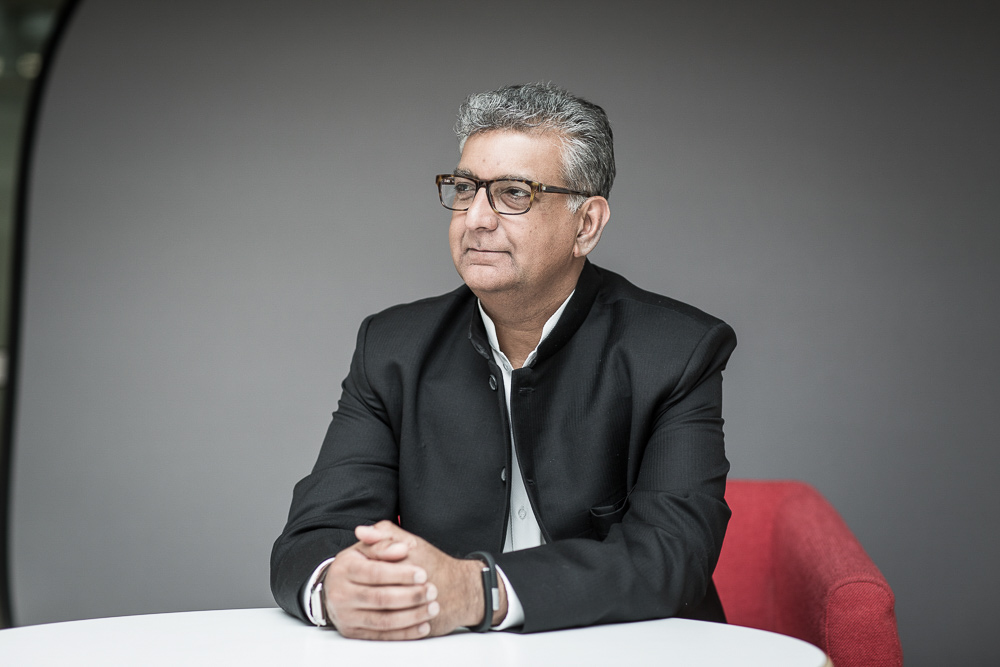
Neil Sachdev’s roles have traversed the public and private sectors throughout his executive and non-executive career. At the heart of his work have been major property, transport and infrastructure developments – which makes him significantly well placed to talk about the importance of place and how to build communities.
At Saxton Bampfylde we worked with Neil in his appointment as a Non-Executive Director, Delivery Authority for the Houses of Parliament Renewal and Restoration Programme. He acknowledges the importance of working collaboratively to create places and communities and the strengths and benefits which can be brought to bear by both public and private sector partnerships to transform the built environment where people can live and thrive. However, what we must also consider, he says, is that we need to be continuously asking how we can do things better and look to other regions and countries to learn and improve.
We are delighted that Neil took the time to talk to us and share his views and experiences with such candour and clarity.
Can you share your view of what placemaking is and why it is important?
Placemaking in my view is the reality of a place where people work, live and play. It is also now a place of wellbeing for people. It is about creating a sustainable area where communities thrive. I don’t think there is an art or science in this – it is more about a philosophy of what we mean when we bring a community together, what do we need them to have to be able to thrive and prosper both in terms of wellbeing, environmentally and financially.
Good placemaking requires partnership and the coming together of public and private sector to enable this.
There is more and more of that happening, but I believe we need to look more closely at the results it is delivering and how we determine success.
Has placemaking become more or less relevant in the past 10-15 years and why?
In recent years there has been more focus on the term placemaking but really people have been ‘placemaking’ forever. There is a greater understanding of what it means and can bring as well as a recognition of the philosophy of what we are trying to create in places. I still think that ‘placemaking’ might be the wrong term. We have to think in the longer term and I would suggest that ‘sustainability’ has a stronger connotation of longevity with communities than placemaking does.
What are the dominant drivers and requirements to ensure placemaking, through development and infrastructure is done properly?
When we talk about dominant drivers we need to start with Maslow’s theory of needs: what do people need to be happy and have a fulfilled life? It is not just about a good quality house; it is about how they live their lives completely. We need to think about places where people can stay and don’t feel they need to leave it to enjoy life, work, study and be with family and friends.
It is about access and openness and making sure that that is available to all sectors of our community so we don’t create communes of one demographic. The most effective placemaking and sustainable communities come about when we bring all parts of community together so they can afford to live together and meet their individual needs. These places must have the right infrastructure, from having decent broadband to quality hospitals and transport links to education.
There have been great examples over the years – one such one is Milton Keynes. Whether you love or loathe it, it was beautifully thought through as people can walk everywhere with reasonably good access to public transport. It was It was designed to have trams – it is an American grid system – and the roads are all straight and wide, but they ran out of money. It has a large road network too but as we look beyond cars, it shows the placemaking has not been sustainable in the longer term as the final investment wasn’t there.
Are we truly taking a sustainable enough approach to development and infrastructure?
No, we are not. There is still too much emphasis on the speed of getting something up, rather than thinking about the impact that will have and the whole lifecycle of a development. I don’t think there is a measure for that lifecycle and we need to do more research into this.
Sustainability isn’t simply about using less carbon or less water in development, it has also got to be something that is easy to maintain. Most buildings and infrastructure degrade from the day they are built so we need to think about what good maintenance looks like. There are modern methods of construction that would enable us to create more lasting properties as we go that are easier to improve and not degrade as time passes and we need to consider this much more carefully.
Massive infrastructure projects like East West Rail – what benefits does this bring to the economy, the environment and the community?
The rail connectivity across England is an issue – we don’t currently connect East to West properly at the moment. There are pockets of good connectivity, but it is not comprehensive enough. The East West line is sometimes referred to as the Oxford to Cambridge line but that doesn’t highlight the much wider connections that come from it. Across that corridor are the two bastions of the best academic institutions in the world, producing large numbers of expanding SMEs and lots of life science research and development. We have the potential to create the next Silicon Valley in this region, which means high net worth jobs for many people, spilling much wider benefits into the immediate area.
Modelling shows that connecting Bedford to Cambridge will create 80,000 good, well paid jobs. Cambridge doesn’t have room for more housing, but it does need ways to bring in more employees. The risk of us not putting money into infrastructure is that business will go elsewhere. We are already facing a significant ‘brain drain’ in that region and we need to find a way to stem this. People need to find it easier to get to Cambridge. Rail does allow people to move around, plan lives and travel when they want to. It enables mass transit on a very low carbon option with a greater potential for productivity versus car travel.
We need to always think with the customer in mind and that is how we need to move forward and think about what the customer needs from the infrastructure and design it from there. I have been with the East West Rail project for 12 months now and am excited to see it develop as we move forward.
Are large infrastructure projects too focused in metropolitan areas – should more be done to enhance connectivity in a wider geography?
There is much PR with strong visuals on certain lines, such as Crossrail, but to be honest I think there is a lot happening cross-country. We have the Cross Pennine and East West Rail projects happening, for example, and a lot was done on electrifying the Great Western Line. We don’t get enough profile for some of these projects but there is a lot of money going into other areas, not just in the metropolitan regions; we just need to speed it up.
How can success be achieved through public and private partnership in development and infrastructure works? Can you please share examples?
We need to consider how we play to each other’s strengths. Public sector organisations on the whole don’t do big developments but the private sector does. The achievements of development at Kings Cross by LCR or the Stratford post-Olympic redevelopment was all done through public and private partnership. The private sector had the vision to create something and the public sector released the land and granted the permissions to make that development possible. There are many exciting opportunities where similar development is being planned for the future – such as Manchester Mayfield, Leeds and potentially York.
There has to be a clear building of trust between partners, as there is often an expectation that the private sector will take more out of it than the public sector, but it is important that each understands the benefits being brought by both elements.
Can (and do) we learn from other countries in their approach to development and infrastructure?
I believe we must learn more about what is going on in other countries so we can adapt it to our sector. We are generally an insular nation and sometimes take the view that if it is not invented here then it can’t be good.
There is a lot of opportunity and a lot of good examples in the UK, but I do struggle to see why we can’t fix the housing crisis. The world is addressing these issues and innovations in modular building technologies being used in housing, particularly in the US, are having great success. We need to think about how that can be utilised and improved here. There are those doing it really well in the UK, but change has taken us too long to start making real impacts on areas like housing.
It doesn’t need to be about reinventing the wheel, but it can be about improving it. We need to be open about it and stop being so risk averse. We need to look at how others are building and are delivering better and more sustainable results.
Pressures on supply chains, utilities and other resources (including people) – what impact is this having on our approach to purposeful placemaking or sustainable living?
Society and general economic pressures are going to be around for 2-3 years, and a lot of businesses will feel that same pressure during that time. With sustainable placemaking I view it that we are planning for the longer term. Whatever we do today is not going to be delivered for 3-5 years, maybe even longer, and that allows us time to think through how we can do things in a different way, be more productive and address challenges properly.
Everything can’t happen today, it will take time, but we do have the desire and skills to innovate and reinvent to find the right solutions. For example, if we did more modular building it would require less resources and less people, and more skilled people who would be paid better.
In the end most of these placemaking projects are not about making money out of the development – it is about the value they create in society and nearby, which will all ends up in the taxpayers’ coffers eventually.
Neil Sachdev MBE – Biography
Neil is an Independent Chair, Non-Executive Director and FTSE/AIM Director with a wide-ranging portfolio and a strong track record of corporate governance, strategy, change management and climate-change sustainability.
Most recently, Neil was appointed Chair of the East West Rail Co Board and Non-Executive Director for the LCR Property Board. Neil is also a Non-Executive Director, Delivery Authority. Houses of Parliament Renewal and Restoration Programme and Chair of the Defence Infrastructure Organisation Board for the Ministry of Defence. Neil holds a number of public sector and Chair positions including Chair for Cake Box Holdings plc and Energy Savings Trust. As independent Formal Council member at the University of Warwick, Neil Chairs the Warwick Business School Board and is a Governor of the Board with Nuffield Health.
Previously, Neil was Group Property Director of J Sainsbury and before that served for 28 years with Tesco, where he was Stores Board Director, responsible for property and operations for the UK business. Neil was awarded an MBE for his work in relation to Energy Efficiency & Sustainability and an MBA from Stirling University which he studied part time whilst starting his career at Tesco.
